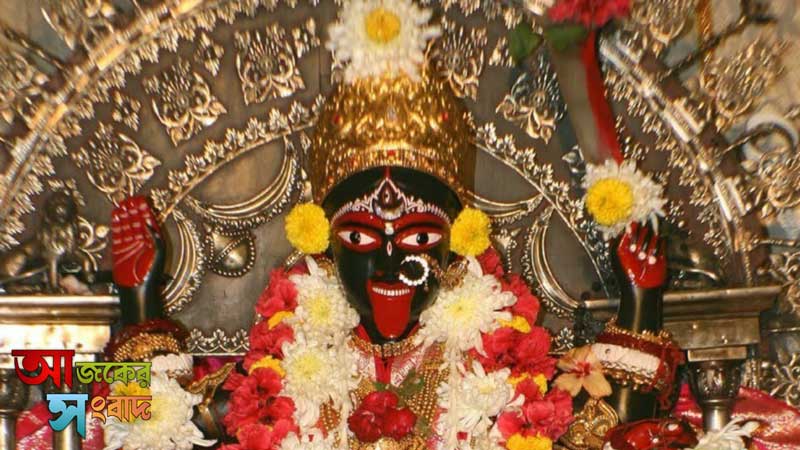
Founded in 1855 by Rani Rashmoni of Janbazar on the eastern bank of River Hooghly, the complex of the Dakshineswar Kali Temple is associated with the holy memories of Sri Ramakrishna, a mystic, saint, and religious leader of 19th century Bengal. While the nine-spired main temple in the complex is dedicated to Bhavatarini Kali, there are 12 other smaller temples along the riverfront, dedicated to Lord Shiva, and a temple of Radha-Krishna.
There is another small building in the northwest corner, named Nahabat, just beyond the last of the Shiva temples, where Sri Ramakrishna and his wife, Sarada Devi, popularly known as Maa Sarada, spent an important phase of their lives. Apart from that, the temple complex includes a library, and a small shrine containing a marble statue of Rani Rashmoni, the founder of the temple, who passed away on 19 February 1861, only five years and nine months after the inauguration of the temple.

Rani Rashmoni, a philanthropist, and a powerful woman during her time, was the widow of Rajchandra Das, a wealthy man of Janbazar. She broke through patriarchy, took the helm of the business of her late husband, amassed a huge fortune, and even rose against the ruling British on several occasions to help her people. She was a pious lady, and sometime in 1847, she decided to go on a long pilgrimage to the sacred city Kashi, with her family members, friends, and relatives, with a huge convoy of twenty-four boats, carrying a band of servants and supplies.
According to the traditional story, the night before the commencement of her journey, she had a dream in which the Goddess Kali advised her to leave her intention to visit Kashi, and instead install her statue in a temple along the River Ganges, and arrange for her regular worship in that temple.

But it was not an easy task, and Rani Rasmoni had to face a lot of opposition, even before the construction of the intended temple. As she was a woman, and that too born of a low non-Brahmin Mahisya caste, nobody agreed to sell land for the construction of a temple to install a Hindu goddess, and earn the wrath of the Brahmins for violating the social norms. However, after a long endeavour by her son-in-law Mathuramohan Biswas, she could procure a big plot of land, locally known as Saheban Bagicha in the village of Dakshineswar, from an Englishman, named Jake Hastie.

It took eight years to complete the construction of the temple complex, partly erected on a discarded Muslim burial ground shaped like a tortoise, which was considered befitting for the Shakti worship according to Tantric tradition. However, that was not the end of it. Rani Rashmoni found it tough to appoint a priest for performing the regular worship as no local Brahmin agreed to serve the temple constructed by a low-caste woman.
Finally, Ramkumar Chattopadhyay, a scholar from Kamar Pukur was engaged as the head priest, and the black stone idol of Kali, meticulously carved by sculptor Navin Pal was installed amid festivities in the temple formally known as Jagadishwari Mahakali Temple on the auspicious Snan Yatra day on 31 May 1855.

The south-facing three-storey temple is built in Bengali traditional Navaratna style with nine spires. The spires or Shikharas are distributed in the upper two stories, and each of them stands on a high platform with a flight of stairs. The temple, measuring 46 sq feet, rises to a height of above 100 feet. The sanctum sanctorum or the garva griha houses the idol of goddess Bhavatarini Kali, standing on the chest of Lord Shiva, lying on a lotus with thousand petals made of silver. The temple is equipped with a 50 feet long and 75 feet wide huge 16 pillared traditional Natmandir, an open hall to serve the purpose of several religious discourses, and live spiritual songs. There is a wide space to the north of the temple, where in later years five trees were planted under the guidance of Sri Ramakrishna and consequently came to be known as Pachavati, consisting of Banyan, Peepal, Neem, Amlaki, and Wood apple tree.

After the untimely death of Ramkumar Chattopadhyay in 1856, his brother, Gadadhar Chattopadhyay became the head priest of the temple, and stayed with his wife, Sarada Devi in a small room on the ground floor of the Nahabat, Subsequently, he became famous as Sri Ramakrishna Paramasamsa Dev.
Dakshineswar Kali Temple is one of the top religious places in Calcutta and attracts thousands of devotees every day.